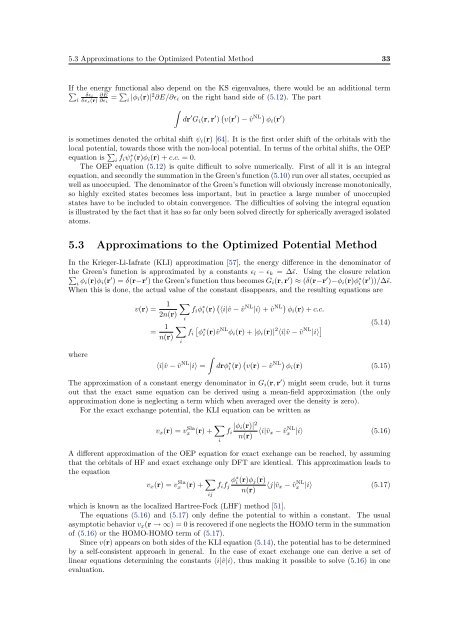Exact Exchange in Density Functional Calculations
Exact Exchange in Density Functional Calculations
Exact Exchange in Density Functional Calculations
Create successful ePaper yourself
Turn your PDF publications into a flip-book with our unique Google optimized e-Paper software.
5.3 Approximations to the Optimized Potential Method 33If the energy functional also depend on the KS eigenvalues, there would be an additional termδɛ i ∂E= ∑ i |φ i(r)| 2 ∂E/∂ɛ i on the right hand side of (5.12). The part∑iδv s(r) ∂ɛ i∫dr ′ G i (r, r ′ ) ( v(r ′ ) − ˆv NL) φ i (r ′ )is sometimes denoted the orbital shift ψ i (r) [64]. It is the first order shift of the orbitals with thelocal potential, towards those with the non-local potential. In terms of the orbital shifts, the OEPequation is ∑ i f iψ ∗ i (r)φ i(r) + c.c. = 0.The OEP equation (5.12) is quite difficult to solve numerically. First of all it is an <strong>in</strong>tegralequation, and secondly the summation <strong>in</strong> the Green’s function (5.10) run over all states, occupied aswell as unoccupied. The denom<strong>in</strong>ator of the Green’s function will obviously <strong>in</strong>crease monotonically,so highly excited states becomes less important, but <strong>in</strong> practice a large number of unoccupiedstates have to be <strong>in</strong>cluded to obta<strong>in</strong> convergence. The difficulties of solv<strong>in</strong>g the <strong>in</strong>tegral equationis illustrated by the fact that it has so far only been solved directly for spherically averaged isolatedatoms.5.3 Approximations to the Optimized Potential MethodIn the Krieger-Li-Iafrate (KLI) approximation [57], the energy difference <strong>in</strong> the denom<strong>in</strong>ator ofthe Green’s function is approximated by a constants ɛ l − ɛ k = ∆¯ɛ. Us<strong>in</strong>g the closure relation∑i φ i(r)φ i (r ′ ) = δ(r−r ′ ) the Green’s function thus becomes G i (r, r ′ ) ≈ (δ(r−r ′ )−φ i (r)φ ∗ i (r′ ))/∆¯ɛ.When this is done, the actual value of the constant disappears, and the result<strong>in</strong>g equations arev(r) = 1 ∑f i φ ∗ i (r) ( 〈i|ˆv − ˆv NL |i〉 + ˆv NL) φ i (r) + c.c.2n(r)i= 1 ∑ [f i φ∗n(r)i (r)ˆv NL φ i (r) + |φ i (r)| 2 〈i|ˆv − ˆv NL |i〉 ] (5.14)iwhere∫〈i|ˆv − ˆv NL |i〉 =drφ ∗ i (r) ( v(r) − ˆv NL) φ i (r) (5.15)The approximation of a constant energy denom<strong>in</strong>ator <strong>in</strong> G i (r, r ′ ) might seem crude, but it turnsout that the exact same equation can be derived us<strong>in</strong>g a mean-field approximation (the onlyapproximation done is neglect<strong>in</strong>g a term which when averaged over the density is zero).For the exact exchange potential, the KLI equation can be written asv x (r) = vxSla (r) + ∑ i|φ i (r)| 2f i 〈i|ˆv x − ˆv x NL |i〉 (5.16)n(r)A different approximation of the OEP equation for exact exchange can be reached, by assum<strong>in</strong>gthat the orbitals of HF and exact exchange only DFT are identical. This approximation leads tothe equationv x (r) = vxSla (r) + ∑ ijφ ∗ if i f (r)φ j(r)j 〈j|ˆv x − ˆv x NL |i〉 (5.17)n(r)which is known as the localized Hartree-Fock (LHF) method [51].The equations (5.16) and (5.17) only def<strong>in</strong>e the potential to with<strong>in</strong> a constant. The usualasymptotic behavior v x (r → ∞) = 0 is recovered if one neglects the HOMO term <strong>in</strong> the summationof (5.16) or the HOMO-HOMO term of (5.17).S<strong>in</strong>ce v(r) appears on both sides of the KLI equation (5.14), the potential has to be determ<strong>in</strong>edby a self-consistent approach <strong>in</strong> general. In the case of exact exchange one can derive a set ofl<strong>in</strong>ear equations determ<strong>in</strong><strong>in</strong>g the constants 〈i|ˆv|i〉, thus mak<strong>in</strong>g it possible to solve (5.16) <strong>in</strong> oneevaluation.












